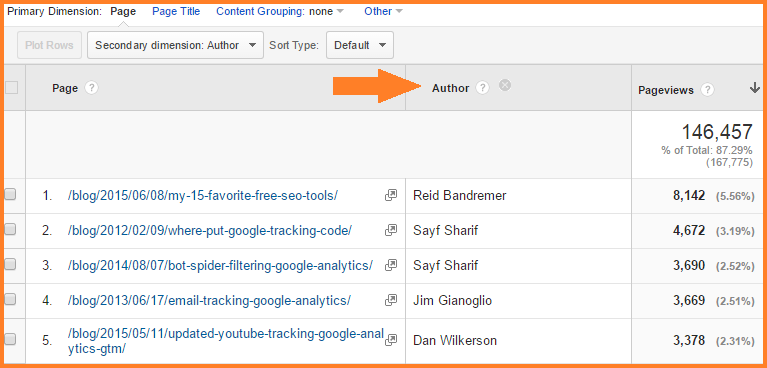Gain Detailed Point Of Views With Secondary Dimension in Google Analytics
Second measurements in Google Analytics act as an effective device for boosting the deepness of understandings acquired from information analysis. Remain tuned to discover exactly how second measurements can change your data evaluation and drive educated decision-making in the electronic realm.
Understanding Additional Measurements in GA
Additional dimensions allow customers to delve much deeper into their information by including an extra layer of details to the primary information being evaluated. By incorporating second dimensions, individuals can segment and compare information across various measurements, such as website traffic resources, user tools, geographic areas, and much more.
Comprehending just how to successfully utilize additional measurements in Google Analytics is essential for drawing out beneficial insights from the information collected. By selecting the ideal secondary dimensions to enhance main metrics, users can uncover patterns, patterns, and relationships that may have or else gone unnoticed. This deeper degree of evaluation can cause even more educated decision-making and the optimization of electronic marketing methods to boost overall efficiency.
Benefits of Utilizing Additional Measurements
Exploring the advantages fundamental in leveraging additional dimensions within Google Analytics illuminates the depth of insights available for enhancing information evaluation. By including additional measurements, customers can acquire a more thorough understanding of their main data metrics.
Furthermore, additional dimensions enable customers to compare and contrast different information factors within the very same report, providing a much more all natural sight of site performance. This relative analysis can clarify the effectiveness of advertising and marketing campaigns, content interaction, or individual demographics. In addition, using secondary measurements can aid in identifying outliers or abnormalities that may call for further examination.
Basically, leveraging second dimensions in Google Analytics supplies a powerful device for removing useful insights and enhancing data-driven decision-making procedures.
Carrying Out Additional Dimensions Successfully
To effectively carry out secondary measurements in Google Analytics, strategizing the choice and application of these additional data layers is vital for optimizing the depth of understandings stemmed from analytics reports. When picking secondary measurements, consider the certain objectives of your analysis to make certain the selected dimensions line up with the details needed to respond to essential inquiries. It's necessary to focus on significance over quantity, choosing measurements that enhance the key dimension and give significant context.
Executing secondary measurements effectively entails using them to uncover patterns, fads, and connections that might not be obvious when evaluating information exclusively based on the main measurement. By incorporating secondary dimensions thoughtfully, you can enhance the granularity of your analysis and gain much deeper insights right into user behavior, material performance, and various other crucial metrics within Google Analytics.
Analyzing Information With Additional Dimensions
Making use of secondary measurements in information evaluation gives a nuanced point of view that reveals complex relationships and patterns within Google Analytics reports. By including secondary dimensions together with main dimensions, experts can dig much deeper into the information to remove important insights. This approach allows the recognition of relationships that may not be immediately evident when assessing data exclusively based on main measurements.
When evaluating information with additional measurements in Google Analytics, it is vital to take into consideration the particular metrics or dimensions that will certainly offer one of the most purposeful context for the primary dimension being analyzed. As an example, combining the key measurement of 'website traffic go to the website source' with additional dimensions such as 'gadget classification' or 'touchdown web page' can provide a much more detailed understanding of customer habits and choices.
Additionally, the ability to section information utilizing secondary measurements enables a more granular examination of customer communications, helping in the optimization of advertising and marketing strategies, internet site efficiency, and general individual experience. By leveraging second measurements successfully, services can make educated decisions based upon a detailed evaluation of their Google Analytics information.
Best Practices for Secondary Dimensions
When executing second measurements in Google Analytics, precision in selecting pertinent metrics is paramount for acquiring actionable insights from the information analysis procedure. Among the very best practices for making use of second dimensions properly is to straighten them with your primary measurement to acquire an extra thorough understanding of your web site or campaign efficiency. If your main measurement is 'Source/Medium,' matching it with secondary dimensions like 'Device Group' or 'Landing Page' can offer insights into just how different gadgets or landing web pages effect website traffic from various resources.

Consistently explore various mixes of main and additional dimensions can aid you uncover new connections and patterns within your information, allowing you to optimize your techniques and enhance general efficiency (Secondary Dimension in Google Analytics). By adhering to these ideal techniques, you can take advantage of second dimensions in Google Analytics successfully to obtain much deeper understandings and make data-driven choices that favorably affect your business

Final Thought
Finally, secondary dimensions in Google Analytics supply a beneficial opportunity to gain deeper understandings right into key data metrics. By adding a secondary dimension to reports, organizations can reveal relationships, patterns, and patterns that might not be immediately obvious, resulting in a much more detailed understanding of individual habits and interactions on a website. Carrying out additional measurements successfully and examining information with them can assist services make data-driven choices and enhance their on the internet performance.
By incorporating secondary dimensions, individuals can section and compare data throughout various measurements, such as website traffic resources, customer gadgets, geographic locations, and more. Carrying out secondary dimensions properly includes utilizing them to uncover Visit This Link patterns, fads, and correlations that might not be evident when evaluating data solely based on the key measurement. By including additional dimensions along with main dimensions, experts can dive deeper right into the information to extract beneficial understandings. One of the finest methods for using secondary measurements successfully is to align them with your primary measurement to acquire an extra thorough understanding of your web site or campaign efficiency. If your main measurement is 'Source/Medium,' combining it with secondary measurements like 'Device Group' or 'Touchdown Page' can give insights right into how various devices or touchdown pages influence web traffic from numerous sources.